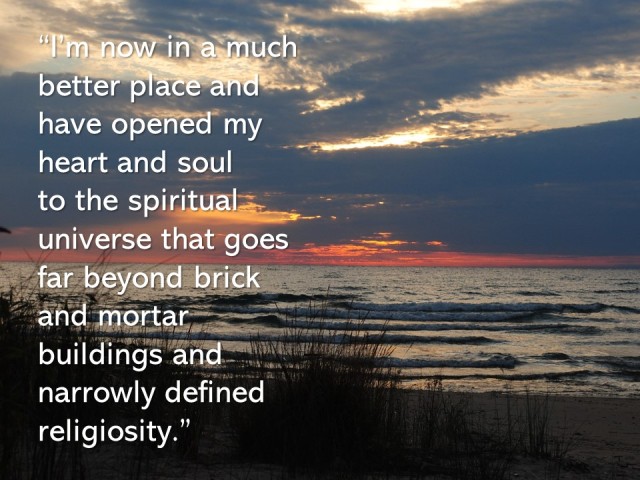
If Near-Death Experiences (NDE’s) are characterized by overwhelming feelings that we are loved by some power greater than ourselves, is it possible that – besides helping us lose our fear of death – they can also help us heal from hurts and traumas?
In the story below, “Andrea” reveals how attempting suicide to escape an un-loving and abusive father resulted in an experience that set her on a path to the best love of all.
By Andrea Garrett
My birth in the early 1950s was overshadowed by physical and mental health issues my father brought home from World War II. A grenade had exploded near him on a beach in France, and it was months before he could be shipped home to Canada. Despite several surgeries for his traumatic brain injuries, he remained plagued by chronic pain. Added to this was severe psychological injury.
When I was born in 1954 to his second wife, Post-Traumatic Stress Disorder (PTSD) had no name nor treatment. His bouts of heavy drinking, unprovoked rage and physical abuse frightened all those around him. My mother finally left him after losing a stillborn boy when I was three. I was left with my grandparents in what became a merry-go-round of staying with them and then sleeping on a couch or camp cot at my dad’s.
Well before I reached my teens, I was developing symptoms of what is now known as Complex PTSD. C-PTSD is experienced by children who grow up in an unpredictable and unstable emotional and/or physical environment. When I was 11, my father’s common-law partner committed suicide after several years of physical and psychological abuse, which I had often witnessed and been a victim of myself.
At age 12, my father took me to a gynecologist to find out if I was still a virgin. He said I was “promiscuous”. He kept me on such a tight leash that I couldn’t have been, even if I had known what the word meant. Decades later, I realized my father made that appointment because he had physically molested me but couldn’t remember what happened. I had fled from that incident in the middle of the night to my grandparents but would not tell them what had happened. I believe my grandfather told his son he needed to have me checked by someone other than our family doctor. I was humiliated to have a total stranger explore ‘down there’.
When I was 13, my father could no longer hold a job or keep an apartment. We moved into my grandparents’ one-bedroom apartment. My dad slept on a day bed in the dining room. I slept on a canvas lounge chair in the same room, which I folded and put away each morning. By this time, my dad was out drinking every day until the last bus. He’d stagger in at midnight and want a cooked meal because he’d missed dinner. He also wanted me to get him up and feed him breakfast before I went to school. But, he could almost never wake up, so I would just go to school, only to be called home to get his breakfast and be raged at for not waking him up.
I couldn’t win. By the time I was 15, I was mentally and emotionally exhausted. My grades were slipping. My morning classes were Math and Physics – not my best subjects and not helped by missing classes. I couldn’t bring friends home and couldn’t join after-school team sports unless I got a note from the coach about the practice and game times so my father could set times for me to be home by “or else”. And then there was the unpredictable and frequent physical abuse. There were days at a time when I couldn’t go to school because of a black eye, swollen face, or cut lip. I lived like this 24/7 for well over two years.
His parents were terrified of his temper. Thankfully, he didn’t attack them, but there were a few shoving matches, with my grandfather threatening to call the police. The one time he did in the summer of 1969, it was to protect me. But the police stayed outside and wouldn’t come in. In my embattled mind, no one could protect me. My spirit was finally broken.
That fall of Grade 11, I took an overdose of my grandmother’s sleeping medication, which landed me in the emergency room and, subsequently, intensive care. While in the ER, I had an out of body experience. I was floating above the bed while nurses were working over me. I then saw out into the hall from the ceiling and watched my father walk out of the hospital, leaving no family to be with me that night. Next I felt myself being drawn to a wonderful, silvery light. It was a soft and caring place. There was an entity there who was ready to welcome me, but I had to make the choice to go there or go back. I wanted to go with that spirit, but I chose to go back after the entity told me there were things my soul needed to learn.
I spent a month on the psychiatric ward. I had few visitors because people weren’t supposed to know where I was. Social services made one home visit, and I came back to a bed with a mattress in my grandparents’ bedroom. There were also no more calls to leave school and no more midnight meals to make. My dad stepped up his drinking. Both he and my grandmother died less than a year later, just eight weeks apart.
I’m now 65 and learning more than I have in all the past years as a teen, adult, mother, and now grandmother. The one thing I have finally learned is to love myself, warts and all. I’m learning that to truly love others, I must first love myself. It’s taken me decades, plus cancer and heart disease, to understand this. I’ve also forgiven my father. My real father was a good, kind, smart, and funny person who became trapped without adequate treatment for his broken mind and body.
I’m now in a much better place and have opened my heart and soul to the spiritual universe that goes far beyond brick and mortar buildings and narrowly defined religiosity. As Susan Aglukark sang back in the 80s: “O Siem, we are all Family. O Siem, we’re all the same . . .”
—Andrea Garrett
November 2019
The author has changed her name to protect her identity .
The Meaning of Forever Project continues to accept stories of comforting experiences with loved ones who have passed on, and of near-death experiences that have helped to show the continuation of life beyond the physical body. You can email your story to us at themeaningofforever@gmail.com and you can find more about our project on our Facebook page, and our Meaning of Forever Website.


